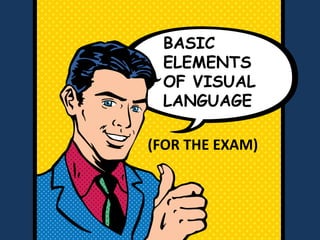
Basic elements of the visual language
- 2. THE DOT
- 3. 1.Definition
- 4. •The dot is the smallest and simplest element of visual language. •Its first target is to indicate a position since it doesn´t follow any direction.
- 6. We can create different visual effects like : •concentration (gathering) = dots are grouped •dispersion (spreading) = dots are at a distance
- 7. 4.Dot´s uses We can use dots for:
- 8. Shading: To shade images to give them a sense of volume. Dots that are close together make darker areas; dots that are farther apart make lighter ones.
- 9. Colouring: to colour the objects and figures we create. A colour is uniform if the dots are at an equal distance from each other. If the dots are closer together, the colour is more intense than if they are further apart.
- 10. Giving images a sense of depth: Smaller dots seem further away, larger dots seem closer.
- 12. THE LINE
- 13. 1.Definition
- 14. • When a dot moves, it leaves a trace that we see as a line. So, a line can be defined as the graphic representation of a dot in motion. •A graphic line must always be longer than its width. It has a position and a direction in space and one of its main functions is to delimitate the outline of shapes
- 15. 2.Types of lines
- 16. Lines can be classified in: •Simple lines are made in just one stroke, straight or curve. •Composed lines are made of fragments of two or more straight or curve lines.
- 17. The COMPOSED LINES can also be: •Zig Zag or Broken lines: They are formed by fragments of several straight lines with different directions. •Wavy lines: They are formed by several fragments of curved lines. •Curly lines: They hold more curves than wavy lines and show loops. •Scribble/Doodle: Chaotic or meaningless lines that are traced randomly. Dashed (or dotted) lines: They are lines which are not continuous, formed by little traces or dots.
- 18. 4.Line´s uses We can use lines for:
- 19. Dividing the space: The line is the principal element used to structure space.
- 20. SHADING We give a shape a sense of volume and depth when we shade it with lines. We can shade dark areas by drawing parallel lines close together or shade lighter areas by spacing the lines further apart. This way of drawing is called HATCHING
- 22. THE SHAPE
- 23. 1.Definition
- 24. Shape is a two-dimension (length and width) area or mass which defines objects in space. These objects can be defined by colour contrast, by different textures or they can be delimited by contour lines. In this last case shape is the area of a surface within a closed line.
- 26. GEOMETRIC AND ORGANIC •Geometric: shapes which parts follow a mathematical order, law or pattern. They can transmit strong visual sensations of order and stability. •Organic: shapes that have irregular profile. They give a visual sensation of more dynamism than geometric forms.
- 27. OPEN AND CLOSED SHAPES •Open shapes: shapes that are not completely enclosed by a line. Usually, the content of these shapes comes out to get mixed with other elements or the background. •Closed shapes: shapes that are completely enclosed by a line or unbroken contour. The outline is generally well defined.
- 28. POSITIVE AND NEGATIVE SHAPES •Positive shapes: the objects or figure on which the viewer focuses. •Negative shapes: the empty space (or the space filled with other imagery) left over in the art work.
- 29. Parts of a shape
- 30. OUTLINE It is the line enclosing the shape of an object in a drawing or image. In art it is sometimes called CONTOUR.
- 31. SILHOUETTE It is a shape filled up with a solid colour, just like a shadow.
- 32. INFILL The inner part of a shape. It is usually formed by lines, dots, colours and textures.
- 33. TEXTURE
- 34. 1.Definition
- 35. Texture is the visual and tactile quality of surfaces due to the material structure of the object. It can transmit different visual and tactile sensations. Artists use textures as another plastic element to reach more expressivity in their works.
- 36. 2.Types of textures according to their origin
- 37. •NATURAL TEXTURES: those that can be found in nature. •ARTIFICIAL TEXTURES: those manually or mechanically elaborated by man.
- 38. 2.Types of textures according to their dimension
- 39. TACTILE TEXTURES: •We can perceive them through the sense of touch. They have the appearance of a three- dimensional relief. •In plastic representation - painting or sculpture-, we can perceive a lot of tactile effects combining different materials or making surfaces with the relief we want.
- 40. VISUAL TEXTURES: •We perceive visual textures only with our sight. They are strictly two-dimensional. •We also call them graphic textures, because they are photographs or representations on paper or on other materials.